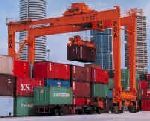WhereNet, a provider of wireless asset-management systems that utilize RFID tags to track goods, has enhanced its offering by integrating optical character recognition (OCR) with technology from PACECO, a maker of cranes and other container-handling equipment for marine terminals. The new offering—called the WhereNet Marine Terminal Management Solution—replaces the manual processes terminal operators now use to track the container from ship to terminal, and vice versa.
“Real-time visibility to each container’s position in the terminal enables the terminal operator to process an import container more efficiently and more quickly,” says John Scott, director of marine terminal solutions for WhereNet, which is based in Santa Clara, Calif. “This equates to increased throughput and reduced operating expenses for the terminal operator, and to reduced wait times at the terminal for third-party truckers seeking to pick up a container.”
By using a digital camera and OCR technology to record unique identifying information printed on a shipping container, the Marine Terminal Management Solution gives a terminal operator the ability to track thousands of containers within the terminal without the hassle or expense of having to tag each container. The solution works by using the WhereNet real-time location system (RTLS) to determine the whereabouts of a Transtainer—PACECO’s gantry crane—employed by a terminal operator to position the containers in stacks up to four units high and six units wide. The WhereNet RTLS keeps tabs on the crane via an attached WhereNet transponder, which is monitored by RFID readers installed throughout the yard.
To pinpoint a container’s location, the Marine Terminal Management Solution monitors critical sensors on the crane, such as those on the twist locks that engage a container prior to lifting. To accomplish this, WhereNet’s system works in conjunction with PACECO’s own Position Tracking Interface Unit (PTIU) integrated into each crane. Interfacing with the crane’s existing programmable logic controller, the PTIU tracks a container’s height and lane as it is being stacked. That container-related location information is relayed to the crane’s WhereNet RFID tag, which forwards it to RFID readers. The WhereNet RTLS then broadcasts the container’s position across WhereNet’s Wi-Fi wireless LAN, which lets the mobile workers receive information on container and equipment locations via touch screen computers.
By combining WhereNet’s RTLS and Wi-Fi wireless LAN with third-party optical character recognition technology, the Marine Terminal Management Solution eliminates the need for yard workers to enter the information manually and lets terminal operators manage their operations from one system. For example, when a drayman or third-party truck arrives at a gate entrance to begin WhereNet’s automated check-in process, an RFID reader reads the truck’s unique ID information provided by a permanently mounted WhereNet Tag, affixed to either the chassis or the cab of the truck. (If no permanent tag is in place, temporary tags can be affixed to the truck instead.)
The tag can be associated with trip-specific data previously stored on the system, for example, such as a manifest that lists what the truck is dropping off at the yard. If the drayman arrives with a container for export, an OCR-enabled digital camera mounted at each gate can capture the unique identification information printed on the container at the same time a WherePort (an excitor device) activates the WhereTag attached to the drayman’s truck. The two identifiers remained linked in the system until the drayman or third-party driver drops off the load in the yard.
Once it’s activated by the WherePort’s electro-magnetic field, the WhereTag begins to transmit its ID at regular intervals called a “blink” pattern, enabling the yard’s RFID readers to keep track of a truck’s and container’s location. Based on information sent from the WhereTag attached to the drayman’s truck, a PC in the crane operator’s cab wirelessly receives confirmation of the drayman’s ID and the container that needs to be dropped off. The wireless PC can then direct the crane operator where to place the container to a specific location in the stack and, later on, where to quickly find that container when it needs to be retrieved.
The Marine Terminal Management Solution has already been successfully piloted at Trans Pacific Container Service Corp. (TraPac), a West Coast container terminal operator and stevedore. In order to keep up with increasing volumes, terminal operators have to be more efficient in “turning” containers—the process of moving containers into and out of the yard, says Frank Pisano, vice president for TraPac. To do so, you’ve got to know the exact whereabouts of your yard assets, he says.
Not only does the Marine Terminal Management Solution let terminal operators do that—according to WhereNet—it lets them do that simply.
“WhereNet’s solution provides the flexibility to track and monitor large container-handling equipment with a single tag by enabling a terminal operator to simply add a cabled WhereTag to a Transtainer’s existing programmable logic control,” says Scott. “Competing solutions are more cumbersome and expensive as they require GPS, additional sensors, an onboard computer and a communications link to be installed on each Transtainer.”
The WhereNet Marine Terminal Management Solution system, available now, starts at $250,000.


